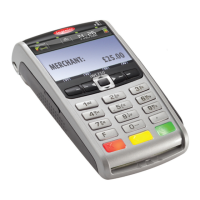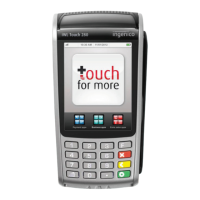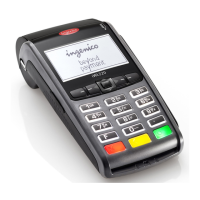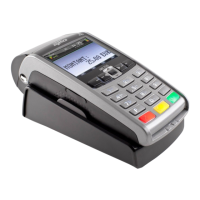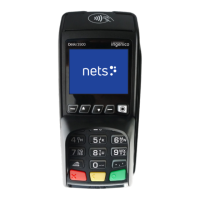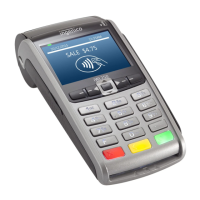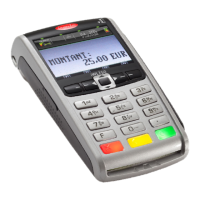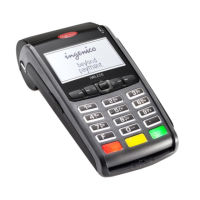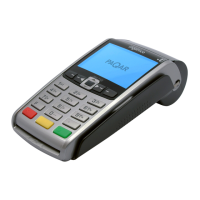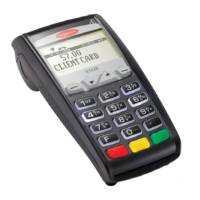
Do you have a question about the Ingenico iWL200 Series and is the answer not in the manual?
| Brand | Ingenico |
|---|---|
| Model | iWL200 Series |
| Category | Payment Terminal |
| Language | English |
Expresses gratitude for choosing the Ingenico iWL200 Series Wireless Payment Terminal.
Recommends thorough reading for optimal terminal use and explains conventions used in the guide.
Advises on storing transaction receipts and End of Day reports for a minimum of 6 months.
Directs users to the Quick Start Guide for Helpdesk contact and mentions TID/S/N.
Guides on checking for tampering signs, security seals, and unusual wires on the terminal.
Provides instructions for cleaning the terminal safely using a soft cloth and avoiding liquids.
Explains the monthly TMS call for software updates and configuration changes.
Details the default password and the mandatory requirement to change it before first use.
Clarifies that the terminal is 'online' and requires End of Day reports to be performed.
Advises using only approved paper rolls and indicates where to find ordering details.
Outlines essential preliminary steps before operating the terminal, including reading the guide.
Lists all the items included in the terminal's packaging for user reference.
Describes the iWL200 series as a compact, ergonomic payment terminal with three variants available.
Provides a visual guide to the terminal's key components and features.
Details the terminal's base unit, its connection ports, and instructions for accessing its cover.
Explains the process of installing the rechargeable battery pack and identifying battery status icons.
Illustrates the terminal's keypad layout and explains key functions and input methods.
Shows visual examples of various terminal display screens and their indicators.
Describes how to navigate the terminal's menu structure using function keys and menu navigation.
Guides users through the procedure for pairing the terminal with a compatible Bluetooth base unit.
Explains how to connect the terminal via telephone line or LAN, including PSTN prefix setup.
Provides instructions on correctly inserting the SIM card into the terminal for mobile operation.
Details the process for configuring Wi-Fi network connections, including security standards compliance.
Offers a step-by-step guide for creating and saving a new Wi-Fi connection profile.
Explains how to manually choose and activate a saved Wi-Fi connection profile.
Guides users on how to modify the settings of an existing Wi-Fi connection profile.
Details the procedure for deleting a previously saved Wi-Fi connection profile.
Provides clear instructions on how to replace the paper roll in the terminal's printer.
Explains the primary method for initiating a sale transaction by entering the amount directly.
Describes contactless payments above the limit, verified by Cardholder Device CDCVM.
Addresses common issues during contactless card reads and provides troubleshooting steps.
Details how to print a duplicate customer receipt, especially for contactless transactions.
Step-by-step guide for processing sales using inserted chip cards via Method One.
Step-by-step guide for processing sales using inserted chip cards via Method Two.
Provides instructions for processing sales transactions using contactless cards.
Details the procedure for processing sales transactions by swiping cards.
Explains how to enable and utilize the Gratuity/Tip mode for adding tips to transactions.
Guides on processing sales with gratuity for inserted cards using the on-screen prompt.
Explains processing sales with gratuity for inserted cards via the on-ticket method.
Details processing sales with gratuity for swiped cards, including signature and tip entry.
Explains how to process sales transactions that include providing cashback to the customer.
Describes the functionality for dividing a total bill amount among multiple customers.
Explains the surcharge feature for automatically adding set amounts or percentages to transactions.
Details the step-by-step process for executing refund transactions on the terminal.
Guides on performing mail order transactions where the customer and card are not physically present.
Explains the outcomes of Card Security Code (CSC) and Address Verification Service (AVS) checks.
Details the procedure for manual entry of card details for mail order sales and refunds.
Describes performing account verification to confirm card validity without impacting the customer's balance.
Explains the use of Hotel Mode for pre-authorising large value transactions, common in hotels or rentals.
Details how to reverse a transaction immediately after completion if an error is detected.
Explains the process of printing duplicate customer receipts for the most recent transaction.
Guides users on how to perform cash advance transactions using the terminal.
Describes performing authorisation-only transactions to check credit limits without capturing transaction details.
Explains the various messages and procedures encountered when a transaction is declined.
Details transactions that require voice authorisation due to additional security checks by the acquirer.
Explains how to complete transactions using a previously obtained authorisation code.
Shows an example of a merchant copy receipt for signature-based transactions.
Provides an example of a merchant receipt for signature transactions that include gratuity.
Illustrates an example of a merchant copy receipt for transactions requiring a PIN entry.
Shows an example merchant receipt for PIN transactions that include gratuity.
Presents an example merchant copy receipt for contactless card transactions.
Displays an example customer copy receipt for keyed card transactions with signature.
Shows an example customer receipt for inserted card transactions requiring PIN entry.
Provides an example customer copy receipt for contactless card transactions.
Displays an example customer copy receipt specific to pre-paid card transactions.
Features examples of receipts generated for declined or voided transactions.
Explains the functionality of transaction referencing for operators, locations, or other identifiers.
Details the one-touch procedure for generating the End of Day report and its importance.
Explains how to perform a Banking report to reconcile terminal totals with acquirer totals.
Describes the X Balance report, used for printing transaction totals without resetting terminal data.
Details the Z Balance report, used for printing transaction totals with a reset of terminal data.
Explains how to print a report showing transactions stored in the terminal awaiting transmission.
Describes the TMS report which indicates the success or failure of the terminal's management system calls.
Explains the purpose of the Supervisor password and provides guidance on changing it.
Guides on how to change the Supervisor password during the first transaction.
Discusses the option of setting a separate password specifically for Refund functions.
Details how to access and navigate the various Supervisor menus on the terminal.
Outlines functions available on the first Supervisor menu screen, including Handset ID and Password.
Covers functions on the second Supervisor menu screen, such as Tips and Op Mode.
Details functions on the third Supervisor menu screen, including Intl and Saletype.
Lists functions on the fourth Supervisor menu screen, such as Date Time and Backlight.
Summarizes functions within the Password sub-menu, including data deletion and password resets.
Details functions within the first Config menu screen, such as printing EMV data and setting PSTN prefixes.
Lists functions available on the second Config menu screen, specifically mobile network selection.
Outlines functions accessible via the Shortcut menu, including Contactless and Bluetooth settings.
Details functions on the second Shortcut menu screen, specifically Wi-Fi setup.
Addresses common user queries regarding terminal status, printing, passwords, SIM codes, and PIN attempts.
Provides solutions for problems related to mobile network display and Bluetooth terminal status.
Offers guidance on handling situations where a customer has forgotten their PIN code.
Troubleshoots frequent transaction referrals and common problems with contactless transactions.
Explains how to adjust the screen contrast on specific iWL221 & iWL222 models.
Lists and explains various on-screen messages indicating errors or providing information.
Continues the explanation of screen messages related to processing errors and invalid operations/cards.
Details screen messages concerning memory status and specific contactless transaction scenarios.
Lists and explains diagnostic (DIAG) codes that may appear on receipts and reports.
Continues the list of diagnostic codes, including those for communications errors and invalid data.
Presents a visual diagram illustrating the terminal's menu hierarchy for easy navigation.
Details the CE marking, essential requirements, and compliance with harmonised standards.
Specifies the terminal's electrical supply characteristics and recommended operating/storage temperatures.

